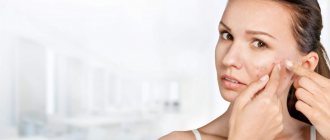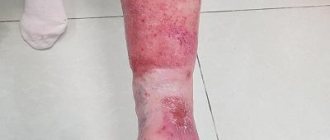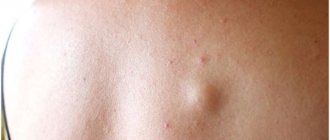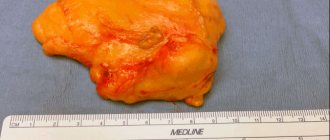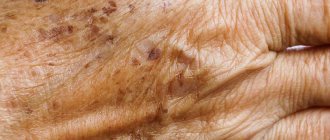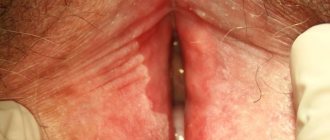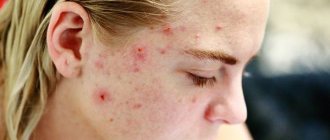Skin diseases are accompanied not only by pain and severe discomfort, but also by the risk of unaesthetic scars or scars appearing on the skin. Therefore, it is extremely important to promptly contact a dermatologist who can diagnose the disease at an early stage and prescribe effective therapy. Our medical center provides the opportunity to receive qualified medical care, as a result of which it is possible to accurately diagnose and eliminate signs of skin damage. One of the most common problems with which patients come in this direction is demodicosis. This is a rather dangerous and problematic pathology, which is almost impossible to cope with on your own.
What is this?
Demodicosis in humans develops as a result of reproduction in the hair follicles, sebaceous glands of the skin and meibomian glands of the iron mite (Demodex). The breeding ground for the development of this parasite is sebum, so its main habitat is the skin of the face and external ears. But with a complicated course and lack of timely treatment, the skin of the chest and back is involved in the pathological process.
It is important to understand that healthy people can also be carriers of such a tick, since it is a representative of normal microflora. According to official statistics, about 60% of people are infected with Demodex, but not everyone develops this parasitic disease. Demodicosis of the body develops with the slightest disturbance of the biocenosis and a drop in immune defense.
Causes of demodicosis
As mentioned above, the main reason for the development of this disease is the active reproduction of the iron mite. There are several possible reasons that can lead to increased activity of these opportunistic microorganisms. These are internal and external factors. The first category includes:
- A significant drop in immune defense and exhaustion of the body caused by poor nutrition, autoimmune pathologies, previous diseases, constant stress, etc.;
- Viral and microbial diseases that occur in chronic forms (hepatitis, tuberculosis, etc.);
- Helminthiases. The vital activity of helminths contributes to the weakening of the immune system;
- Malignant neoplasms. With many types of oncology, the body becomes exhausted, making it more difficult for it to cope with infections;
- Damage to the gastrointestinal tract. There is a proven relationship between the bacterium Helicobacter pylori and demodicosis;
- Other skin diseases. These are seborrheic dermatitis, rosacea, acne, etc. In the presence of inflammatory processes or integrity disorders on the skin, the risk of pathogenic activation of opportunistic flora increases significantly;
- Hormonal imbalance associated with illness or natural condition (for example, pregnancy or breastfeeding).
Skin demodicosis can also develop as a result of exposure to unfavorable external factors. As a rule, they are combined with internal ones, but in some cases (for example, choosing the wrong skincare products) they can be the main etiology. Among them:
- Temperature effect. This parasite multiplies especially actively in warm conditions;
- Unhealthy Lifestyle. This includes poor nutrition, frequent stress and bad habits;
- Use of low-quality cosmetics for care. This is especially true for cosmetics that do not have quality certificates and do not meet legal requirements;
- Poor environmental conditions. High levels of environmental pollution lead to a weakening of the barrier function of the skin.
Demodectic mange symptoms
Due to the fact that this disease can affect different areas of the skin, the clinical picture differs. In the cutaneous form, the following signs of demodicosis appear:
- Acne of varying severity: from small nodules and ulcers to rosacea;
- A strong tooth that causes discomfort. In most cases, it intensifies in the evening and night;
- Excessive sebum production. It is the greasy environment that is most nutritious for ticks of this genus;
- Red spots that are a symptom of high blood pressure in the blood vessels. This indicates the presence of an inflammatory process in the body;
- Nose enlargement. If you contact a dermatologist late or in the absence of adequate treatment, it is possible to replace the functioning tissue with connective tissue.
Demodicosis of the eyelids and eyes, in turn, manifests itself as follows:
- Clumping of eyelashes. Along their growth line, a thin layer of film is formed that has adhesive properties;
- Redness of the eyelids as a result of the inflammatory process;
- Tired eyes. This symptom occurs due to inflammation and due to the fact that the patient is forced to strain his vision;
- Eyelash loss caused by damage to hair follicles.
Indications for the use of ointments and gels for demodicosis of the eyelids
Ointments for demodicosis should be used at the first symptoms of this disease, namely the following signs:
- swelling of the edges of the eyelids;
- eye fatigue against the background of developing inflammatory infectious processes;
- loss of eyelashes that lose their strength;
- redness of the eyelids.
Such inflammatory reactions can be noticed already in the first days of the development of the disease.
And if inflammation affects only the eyelids and practically does not spread to the conjunctival membrane, it is necessary to use ointments and gels for demodicosis.
Diagnostics
Demodicosis on the face and skin is diagnosed by a dermatologist. If the disease is secondary and has developed against the background of the underlying disease, then doctors of other specialties (gastroenterologist, gynecologist, trichologist, endocrinologist, etc.) may be involved for diagnostic and therapeutic purposes. For diagnosis, first of all, visual inspection is used. The doctor evaluates the condition of the skin, eyes and affected areas of the body. In addition, eye biomicroscopy and laboratory examination methods are practiced. The most informative of them are:
- Slit lamp biomicroscopy of the eye is a non-invasive examination aimed at looking for active inflammation. This is an absolutely painless manipulation that does not require special preparation;
- Eyelash test - involves taking freshly removed eyelashes (4 from each eyelid) for further examination under a microscope. Using this method, it is possible to determine the number of parasites (the presence of more than 1 mite on 2-4 eyelashes is pathogenic). This is also a painless procedure, but before it is carried out it is necessary to abandon decorative and skincare cosmetics for several days;
- Biopsy. This is the most informative diagnostic method, but the most traumatic. Diagnosis is carried out under local anesthesia using a tubular knife or scalpel. The taken biomaterial is fixed in a formaldehyde solution for a day and treated with dyes. This makes it possible to fully visualize the gland and adjacent tissues with the pathogenic mite.
Methods for diagnosing demodicosis
The symptoms of demodicosis coincide with the symptoms of some other diseases (dermatitis, allergies). Acne with demodicosis is similar to the manifestations of rosacea (rosacea disease). Therefore, laboratory diagnostics are necessary to confirm the diagnosis.
Demodex analysis
The material for analysis is a scraping from the skin. If the eyelids are affected, eyelashes are taken for analysis. Next, a microscopic examination is carried out, which is designed to detect tick individuals or eggs.
More information about the diagnostic method
Sign up for diagnostics To accurately diagnose the disease, make an appointment with specialists from the Family Doctor network.
Classification
Demodicosis (photo can be found below) is classified into 2 main clinical forms - primary and secondary. The first diagnosis is made in the event of a sharp surge in parasitic reproduction and effective treatment with the use of antiparasitic drugs. In most cases, it occurs in people over 40 years of age. The secondary form is diagnosed by identifying concomitant skin lesions and systemic diseases (usually associated with immunodeficiency). In some cases, this diagnosis is found in people taking epidermal growth factor receptor inhibitors and in those who have been exposed to ultraviolet radiation.
Based on the symptoms manifested on the skin, the following types of demodicosis are distinguished:
- Acneiform - the presence of papules and pustules similar to acne;
- Rosacea-like - papules appear due to diffuse erythema;
- Seborrheic - skin rash combined with peeling;
- Ophthalmic - inflammation of the eyelids, accompanied by discomfort in the affected eye.
Complications of the disease
Treatment of demodicosis on the face should be carried out exclusively with the assistance of a doctor. Self-medication or ignoring this problem may not only not bring the desired result, but also worsen the course of the pathology. Skin scratching and regular trauma to the skin (due to severe itching and the patient’s desire to remove the rash mechanically) lead to disruption of the barrier function. As a result, the risk of developing a pustular infection significantly increases, which can be diffuse and affect large areas of the body.
In addition, this disease (especially demodicosis on the face in women) leads to psychological problems. As a result of the appearance of visible defects, the patient becomes withdrawn, begins to feel embarrassed about his appearance and stops leading a full-fledged lifestyle (closes himself off from the outside world, stops communicating with people, prefers to be alone). As this problem worsens, the developed complexes can develop into psychoses, neuroses and prolonged depression.
A large number of people with this diagnosis have concomitant pathologies (gastrointestinal tract, endocrine glands, etc.) and chronic infectious foci. Demodicosis damage to the body contributes to the aggravation of these conditions and, accordingly, deterioration of well-being.
How the disease develops
Demodectic mange on the face can develop in several stages. Characteristic symptoms appear as follows:
- The skin on the face turns red. At the same time, the person feels irritation on the skin and heat. At first, the redness is temporary, intensifying in bright sun, after exercise, or drinking hot drinks.
- The redness becomes persistent and permanent. The face is red, especially on the cheeks, chin, nose, and in some cases on the forehead.
- Blood vessels dilate , spider veins appear on the face.
- Papules and pustules develop. These are painful ulcers, acne. They are painful, do not last long, and scars form in their place.
- Rhinophymas appear on the nose - these are compactions, small tumors on the skin. The blood vessels and sebaceous glands become inflamed, the nose enlarges and becomes shapeless. More often, this symptom is characteristic of men with demodicosis on the face.
All this is accompanied by increased sebum secretion or dryness. The skin becomes rough. The person feels burning and itching. There is a tingling sensation on the face and the skin hurts. The face becomes noticeably swollen and swollen due to impaired lymphatic drainage.
Demodicosis of the face is often, but not always, accompanied by demodicosis of the eyelids. Symptoms of eyelid damage include redness, irritation, dryness, and a feeling of a foreign object in the eyes. The eyelids become inflamed and blepharitis appears. Eyelashes stick together and fall out. The eyes are constantly inflamed and tired.
Skin demodicosis
The transmission route is contact or contact-household. Can be transmitted through contaminated clothing, bedding, contaminated hands and more. Demodex is distinguished by its survivability under comfortable conditions that correspond to the daily life of most people. The parasite remains viable at a temperature of 17-20°C for 10 days or more, and in an aquatic environment at a temperature of 12-18°C for 3 days. When water is heated to 50° C, the microorganism dies within one minute, and at low temperatures it dies immediately.
To date, there is no single theory explaining the etiology of the development of the inflammatory process and the active reproduction of mites. But there are several predisposing factors that can provoke these processes:
- Excessive sebum production;
- Improper skin care, abuse of cosmetics (especially low quality);
- Long-term use of external corticosteroids;
- Poor nutrition (abuse of sugar, soda, spicy foods, coffee, alcoholic drinks);
- Concomitant gastrointestinal diseases;
- Reduced immunity;
- Hormonal imbalance, excess weight;
- Psychological problems, frequent stress.
Demodectic mange of the eyelids
Treatment of demodicosis of the eyelids requires a comprehensive approach and qualified medical intervention. Demodectic blepharitis is a chronic disease that occurs with periodic exacerbation and remission. It has the following clinical picture:
- Severe eye fatigue associated with the need to strain to better focus on an object or letters;
- Intense itching in the eyelashes and eyebrows. Often this symptom intensifies with external exposure to heat, in the evening and at night;
- Foreign body sensation, burning and tingling that does not go away after washing or scratching;
- Sticky discharge from the eyes after waking up;
- Accumulation of foamy contents in the eye corners;
- Hyperemia, swelling and thickening of the eyelids (especially at the edges).
- The chronic form of demodectic blepharitis can be complicated by keratoconjunctivitis, keratitis and dry eye syndrome. Therefore, it is strongly recommended to consult with an ophthalmologist at our clinic, who will be able to prescribe preventative and therapeutic therapy aimed at maintaining eye health.
What is demodicosis: symptoms, diagnosis and treatment
Is your skin flaking and red, rashes appearing, or is itching bothering you? We go to a dermatologist for a diagnosis. With Vladislav Leonidovich Sheinkman, Candidate of Medical Sciences, dermatovenerologist at the Expert Tula Clinic, we are learning how to protect ourselves from demodicosis.
— Vladislav Leonidovich, what is demodicosis and what are the symptoms of this disease?
Demodectic mange is an infection of smooth skin and hair by microscopic mites of the genus Demodex. The mite lives in the sebaceous glands and hair follicles.
To date, 65 varieties of Demodex mites are known, 3 of which are relevant to humans, and the rest parasitize animals.
The mite is most often found on the skin of the face: nose, forehead, chin, as well as the eyelashes and eyebrows.
Clinical signs of demodicosis include redness of the skin, the appearance of nodules and pustules on it, itching, and increased secretion of sebum. If eyelashes or eyebrows are affected, the eyelids may become inflamed. A secondary bacterial infection and scar formation on the skin may occur.
— Is demodicosis the same as rosacea (rosacea) or are they different diagnoses?
Several decades ago, the mite Demodex folliculorum was believed to be the cause of rosacea.
It is currently known that this mite occurs in 90% of people, even with completely healthy skin. Therefore, according to modern ideas, it is believed that the mite can aggravate the course of rosacea.
If I detect signs of rosacea in a patient, that is the diagnosis I make. Even if a subsequent laboratory analysis reveals a mite, I will not make a diagnosis of demodicosis: according to the latest scientific data, its use is not entirely justified. Therefore, it makes no sense to look for differences between demodicosis and rosacea as two different diagnoses.
Sometimes it seems that many people have a kind of “demodecophobia.” The importance of this microorganism should not be exaggerated, if only because it is found in most people and often does not cause any symptoms.
— Demodicosis occurs only on the face or can it affect other parts of the body?
Classic localization is the face. Theoretically, a tick can be detected on the body, but in practice such a diagnosis makes no sense.
— For what reasons does demodicosis occur? Is this an infectious disease?
As I said earlier, Demodex folliculorum is present in most people and is an opportunistic mite.
Demodicosis is reflected in the section of infectious and parasitic diseases of ICD-10, but its classification as an infectious disease due to the conditional pathogenicity of the pathogen is debatable.
Under certain conditions (in particular, when the immune system is weakened - for example, under stress; overheating), Demodex multiplies, causing the clinical manifestations listed above.
An allergist-immunologist at Clinic Expert Smolensk talks about the signs of decreased immunity.
Chemova Ulyana Vladimirovna
— How is demodex mite transmitted?
By contact.
— Not only people, but also animals suffer from demodicosis. Can a person become infected with demodicosis from cats and dogs?
I believe not, since these mites are species specific.
— Why is demodicosis dangerous for humans?
There is no danger as such either for the person himself or for others. The main problem is cosmetic. This, in turn, adversely affects a person’s self-esteem and psychological state.
— Which doctor should you contact if you suspect demodicosis?
See a dermatologist. If eye symptoms are noted, consult an ophthalmologist according to indications.
You can make an appointment with a dermatologist here
Please note: consultations are not available in all cities
— Vladislav Leonidovich, how is demodicosis diagnosed? What tests should be taken if you suspect this disease?
First of all, a microscopic examination of skin flakes from the lesion. Since the manifestations of demodicosis develop against the background of some general disadvantage, according to indications, a consultation with related specialists (gastroenterologist, endocrinologist, neurologist) may be prescribed with appropriate additional research methods (general blood test and testing for hormones, ultrasound of the abdominal organs, etc. .).
Why is an abdominal ultrasound prescribed? The ultrasound diagnostics doctor at the Expert Orenburg Clinic, Anna Viktorovna Poskrebysheva, tells
— How is demodicosis treated?
First of all, strictly follow the doctor’s recommendations. Overheating in any form should be avoided (bath, sauna, bath, working in the sun, in the kitchen without an exhaust hood), as well as hypothermia; limit the use of cosmetics; do not eat hot food.
Sometimes patients, self-medicating, prescribe ointments with hormones. This should absolutely not be done, as it can lead to aggravation of the process.
Medications that affect ticks are prescribed. If there are pustules, use drugs with an antibacterial effect. Cryomassage is used - rubbing with pieces of ice prepared from tea, chamomile or string infusion. Cool herbal lotions and “talkers” based on sulfur, camphor alcohol and boric acid are also used. Treatment of demodicosis can be lengthy.
— What is the prognosis for demodicosis?
It depends on following the doctor's recommendations.
— Is it possible to cure demodicosis using medicines for animals?
It is unacceptable. Medicines for animals have their own specifics, so it is impossible to predict how they will affect humans.
— It is known that the success of treatment always depends not only on the doctor, but also on the patient himself. What does a patient need to do in order to defeat demodicosis once and for all?
Strictly adhere to the treatment regimen developed by a dermatologist, and under no circumstances self-medicate. Eat a healthy and balanced diet, eliminate harmful factors that aggravate the course of demodicosis. Limit, or better yet completely eliminate, the consumption of alcohol, hot, spicy, sweet foods, and coffee.
You might be interested in:
Herpes: how to recognize and cure?
At an appointment with a nutritionist. Soup: is it good or bad?
Themis will not give offense. Who protects the rights of patients in private clinics?
For reference:
Sheinkman Vladislav Leonidovich
Graduate of the pediatric faculty of the Smolensk State Medical Institute in 1994.
From 1994 to 1995, he completed an internship, and from 1996 to 1998, a clinical residency in the specialty “Dermatovenereology”.
Has an academic degree of Candidate of Medical Sciences.
Currently working at Clinic Expert Tula LLC as a dermatovenerologist. Provides reception at the address: st. Boldina, 74
Demodicosis of the ear
This pathology does not always stop at the face. In advanced cases or in the absence of timely treatment, it spreads to neighboring areas of the body, including the ears. In such a situation, it will not be possible to quickly get rid of demodicosis, especially without medical help. Damage to the auricle is accompanied by the following clinical symptoms:
- Intense itching and irritation of the skin. As a result of constant scratching, bruises and microtraumas appear;
- Hyperemia and swelling of the ear, indicating an inflammatory process;
- The presence of red rashes of varying sizes and quantities;
- Pain upon contact with the skin (often a consequence of a violation of the barrier function of the tissue).
How is demodicosis diagnosed?
Demodectic mange on the face is often confused with rosacea and acne. In fact, tick infestation is very often combined with these diseases. When a person has both demodicosis and acne, the rashes are asymmetrical, there are more of them on the cheeks and closer to the temples. Demodectic mange worsens rosacea; due to mites, redness, itching and peeling become stronger.
To understand exactly what causes redness and discomfort, a diagnosis is necessary. If mites are found in the rashes, we can talk about demodicosis, and their number should be more than 5 individuals per square centimeter of facial skin. If there are fewer of them and there are no clinical symptoms, then in this case the person is considered not sick, but a carrier of the tick. It does not require treatment. To detect mites, the skin flakes and the contents of the sebaceous ducts are examined.
Demodicosis of the head
Ticks of the genus Demodex are representatives of opportunistic microflora of the skin on the body, including the head. They are present in almost all people on the planet. In everyday life, their activities do not cause visible discomfort; they exist in a mutually beneficial relationship with humans, fighting harmful microorganisms. But when the immune defense drops and unfavorable conditions set in, the parasites begin to multiply uncontrollably, as a result of which their numbers increase greatly, and the vital activity of these parasites becomes noticeable. This situation can result from:
- Hormonal imbalance;
- Long-term use of antibacterial and hormonal medications;
- Poor nutrition;
- Abuse of saunas, steam baths and solariums;
- Using low-quality cosmetics to care for skin and hair (since demodicosis needs to be treated comprehensively, our clinic specialists help patients choose the right and safe care products);
- Failure to comply with simple hygiene rules.
3.Diagnosis of the disease
After a visual examination and conversation with the patient, the dermatologist prescribes a microscopic examination
.
Material for analysis is taken by scraping the epidermis from the affected areas of the skin. It is also recommended to analyze eyelashes
taken from different parts of the eyes. Express analysis makes it possible to get instant results. During the study, adult ticks, their eggs and shed chitinous shells are discovered. In order for the dermatologist to see a complete picture of the density of mite colonization of the skin, it is recommended not to wash your face for 24 hours before the examination. What is important for making a diagnosis in this case is not the fact of detecting a tick in itself, but the number and activity of the parasite, as evidenced by the number of larvae and eggs.
About our clinic Chistye Prudy metro station Medintercom page!
Demodicosis treatment
The treatment regimen for demodicosis is a set of measures aimed at eliminating external symptoms and the cause that provoked them. The final stage of therapy is the use of preventive measures that help consolidate the therapeutic result and prevent relapse of the disease. It is important to understand that it is almost impossible to cope with this problem on your own. This problem requires qualified help and long-term drug treatment, since an infected person is dangerous to others. It is a source of infection and can therefore infect other people.
Standard therapy aimed at eliminating demodicosis infection consists of several parts:
- Diet for demodicosis. The patient will need to give up fatty, spicy and smoked foods. It is also recommended to reduce your consumption of sugar, sweets and dairy products. The diet should consist of low-fat fish, vegetables and fruits;
- Local treatment. For this purpose, sulfur ointment is used for demodicosis, creams and sprays that have antibacterial and antiparasitic properties;
- Systemic treatment. It is aimed at normalizing sebum production and eliminating existing imbalances (hormonal or metabolic). To do this, it is possible to involve specialized specialists, prescribe antibiotics in tablet or injection form;
- Symptomatic treatment. It is aimed at improving the patient’s well-being, eliminating active symptoms (inflammation, itching, soreness and redness). For this purpose, a special anti-demodetic mange may be prescribed;
- Physiotherapy. To improve the condition of the skin, electrophoresis, laser therapy and ozone therapy are prescribed.
Since it is practically impossible to cure demodicosis quickly but effectively, the average duration of the treatment course ranges from one to several months. The duration depends on the severity of the pathology and the individual characteristics of the body (in some cases, treatment may take a year or more). The main criterion for cure is a repeat tape test with a negative result.
How to treat demodicosis on the face
To confirm the diagnosis and obtain an effective treatment regimen, you need to consult a dermatologist. All drugs used in the course of treatment must do the following:
- destroy parasites;
- disinfect the skin;
- remove inflammation;
- reduce lard production.
There are various ways to combat demodicosis. Treatment can take up to a year, but usually the treatment time is 2 – 3 months. It consists in applying antiparasitic and anti-inflammatory ointments, creams, and gels to the affected areas of the skin. The most common remedy is sulfur ointment. It kills adult ticks and eggs, disinfects the skin, and promotes its restoration. A wide range of acaricidal drugs are also used. Depending on the degree of damage, they are applied several times a day, and treatment takes from a couple of weeks to several months.
In some cases, topical medications are supplemented with immunostimulating agents to enhance the body's immune response and speed up recovery. If an infection is added to the skin lesions from mites, treatment with antibiotics may be required. This should only be prescribed by a doctor. Itching, burning and tingling are relieved with antihistamines.
In addition to treating the skin, it is important to identify and eliminate the causes that caused demodicosis in humans. If there are problems with the gastrointestinal tract, diet, proper nutrition, and the exclusion of fatty, salty, and sweet foods help. It is also necessary to provide a sufficient amount of water, vitamins, and minerals. Eliminate stressful situations and other circumstances that could cause an exacerbation of demodicosis.
Demodicosis - drugs for treatment
Today, finding effective remedies for demodicosis will not be a problem. The specialists of our medical center select medications in the optimal form on an individual basis, thereby speeding up the healing process. The most popular and effective remedies are described below.
Soap
- Demolan Forte and Stop Demodex demodex.by are especially popular among patients. For demodicosis of the eyelids, the treatment regimen often includes these drugs, as they show excellent results due to the presence in the composition:
- Glycerin - absorbs moisture, holding it on the skin. This helps prevent drying, promotes hydration and improves elasticity;
- Octopirox is an antimicrobial component that inhibits the activity of ticks. It gently exfoliates the top layer of the epidermis, normalizing the process of formation of new cells;
- Propylene glycol - helps normalize microflora, moisturizes the stratum corneum;
- Diazolidinyl urea - provides an antimicrobial effect.
Lotion
Demolan Forte and Stop Demodex lotions are prescribed for constant facial skin care and for cleansing damaged skin areas (even demodicosis on the back) before using the gel. They are often used for eyelid hygiene (for blepharitis), as they deeply cleanse the pores and facilitate the penetration of the active substances of subsequent medications. With their help, it is possible to soften the epidermis and normalize fat metabolism without resorting to tapping the skin. As a result of their regular use, mites are deprived of their nutrient medium, and the tissue is regenerated at an accelerated rate without the formation of scars.
Balm
Therapeutic and prophylactic balm Stop Demodex significantly increases the effectiveness of the main therapy. With its regular use, a visible therapeutic effect is observed after 2-3 days. It has the following properties:
- Anti-inflammatory and bactericidal;
- Moisturizing the skin;
- Promotes rapid tissue regeneration and healing;
- Improves local metabolism;
- Penetrates the cell membrane of the epidermis, replenishes the lack of microelements.
Eye gel
When diagnosing eye demodex, it is strongly recommended to use Demolan Forte and Stop Demodex gels. The presence of peppermint extract in the composition guarantees local anesthesia and inhibition of inflammation. They have a calming and refreshing effect, due to which the patient’s well-being noticeably improves. The presence of metronidazole provides effective antiprotozoal and antibacterial effects, while hyaluronic acid helps improve skin elasticity and firmness. These demodicosis preparations are perfectly absorbed, do not clog pores and do not disrupt cellular metabolism. They accelerate tissue regeneration and prevent the formation of scars.
Cream
An effective cream for demodicosis, Stop Demodex, with constant use, makes it possible to stabilize the normal secretion of the sebaceous glands, restore the skin microflora, eliminate the uncontrolled proliferation of parasites of the Demodex genus and noticeably cleanse the skin from foci of inflammation. It does not contain antibiotics, perfectly nourishes, increases tissue firmness and elasticity, and does not have a comedogenic effect.
Mask
For demodicosis infection, it is strongly recommended to buy a Stop Demodex treatment mask. It contains the active Cutipure complex and white clay, which promotes deep cleansing of pores and reduces the proliferation of pathogenic mites. It has anti-inflammatory, antibacterial and keratolytic effects. Its use allows you to normalize sebum production, tone the skin, improve metabolic processes in cells and accelerate tissue regeneration. Moreover, with its help it is possible to remove toxic molecules.
Shampoo
Using Stop Demodex shampoo for demodicosis of the head, you can significantly reduce itching, eliminate dandruff and stop the active reproduction of parasites. It has a strong anti-inflammatory and regenerating effect, fights mites and helps eliminate the consequences of the disease. Its effect is aimed at preventing ticks from sucking nutrients, disrupting their DNA replication and protein synthesis in the cell. The drug inhibits tissue respiration, which is vital for parasitic life.
Facial care
For treatment to be effective and quick, it is necessary to properly care for your facial skin. It is better to use specialized lines of products, for example, STOPdemodex or Demolan Forte. They help cleanse the skin of excess sebum and remove traces of mite activity. The active ingredients penetrate into the deep layers of the skin and heal it. Series of products include scrubs, masks, soaps, lotions, creams. It is enough to apply them 1 - 2 times a day or periodically, as the manufacturer recommends, but this should be done regularly.
Specialized products improve skin condition, normalize fat metabolism, and remove dryness and discomfort. During treatment, you should avoid decorative cosmetics, and when using them, thoroughly cleanse your skin. Also, you should not visit the bathhouse, sauna, sunbathe on the beach or in the solarium. All this will increase the effect of treatment and help avoid re-infection.
In addition to using special anti-demodicosis products during treatment, you need to thoroughly wash all brushes, sponges and other tools used to apply cosmetics to the face. It is better to replace them with new ones and always keep them clean. You also need to monitor the cleanliness of towels and bed linen, change pillowcases more often, and be sure to iron them after washing. Towels can be temporarily replaced with disposable paper towels.
If demodicosis on the face is not treated, it will become chronic and the deep layers of the skin will be affected. Folliculitis will be added to the external manifestations, and painful ulcers will appear. This will significantly reduce the quality of life. It is better to prevent such development by consulting a doctor in time and choosing special products for daily skin care.
Prevention
Demodicosis of eyelashes and other parts of the body can be prevented. To do this, it is enough to follow simple preventive rules. This:
- Maintaining personal hygiene (regular showering, thoroughly washing your face, washing your hair and hair);
- Eat a varied, rational and healthy diet (include fish, vegetables and fruits in your diet);
- Increased immune defense;
- Correct selection of decorative and skincare cosmetics;
- Do not use other people's cosmetics and personal hygiene products.
Demodicosis in children
- In childhood, this pathology rarely develops (due to the low activity of the sebaceous glands), but its course is much more complicated than in adults. As a rule, in children this disease is chronic, and relapses occur in the off-season. The main signs of the problem are:
- Swelling of the eyelids;
- Loss of eyelashes and hair;
- Severe eye fatigue;
- The appearance of spots on the skin;
- Itching, worse at night and on contact with water;
- Decreased appetite, moody behavior, decreased physical activity;
- Pain in the eyes.
The treatment regimen for democosis of the face and other parts of the body in children is practically the same as therapy for adults. It also includes diet, medication and rehabilitation aimed at healing the tissue and preventing scarring. The fundamental difference in the treatment method is only the dosage of medications, which will be lower in childhood.
Side effects
Such drugs have common side effects , which, according to patients, develop quite rarely when used correctly.
The most common side effect is allergic reactions.
They occur due to individual intolerance or sensitivity to certain components of the drug.
Allergies can manifest as itching, burning and redness of the treated areas of the eyelids.
Additional symptomatic treatment in such cases is not required, but the use of the drug should be discontinued and treatment with any of the analogues should be continued.
Demodicosis in men
Demodectic mange infection occurs in both women and men, regardless of age or race. It has no distinctive features in its course, prognosis, symptoms and causes of development. Therapy is prescribed on an individual basis, but is usually the same for all genders. Differences may only relate to the dosage of medications.
According to statistics, women suffer from demodicosis 4 times more often than men. There is no scientific explanation for this information, but many are inclined to the hormonal theory. It is based on the fact that due to a regular surge of hormones (menstrual cycle, pregnancy), female representatives are more prone to stress and immunodeficiency states. The clinical picture of the disease is standard and includes:
- Skin rash of varying severity;
- Itching, pain and discomfort in the damaged area;
- Increased sebum production;
- Pain in the eyes, sensation of a foreign body.
The treatment regimen for demodicosis for women is standard. It consists of a diet, long-term medication and the use of special care products (oils, lotions, creams, etc.) to prevent relapse and consolidate the therapeutic result.
Questions and answers on the disease
Can a sick person infect others?
Yes, you can become infected with demodicosis through contact and household contact. Kissing, hugging, contact with contaminated things of a patient (towel, bed linen, clothes and much more) can be dangerous for a healthy person. But this does not guarantee the manifestation of symptoms of the disease. Ticks of the genus Demodex are representatives of the opportunistic microflora of the skin. They are found in almost all people, but most of them are simply carriers. For the development of a pathological process, the presence of certain factors is necessary (for example, reduced immune defense against the background of an active or past disease).
Can you get infected from animals?
Animals, like humans, suffer from the activity of Demodex mites. But pathogens come in different types - and each of them survives exclusively in the body of its host. When exposed to other conditions, the parasite immediately dies. Therefore, it is impossible to become infected with demodicosis from a pet or wild animal.
